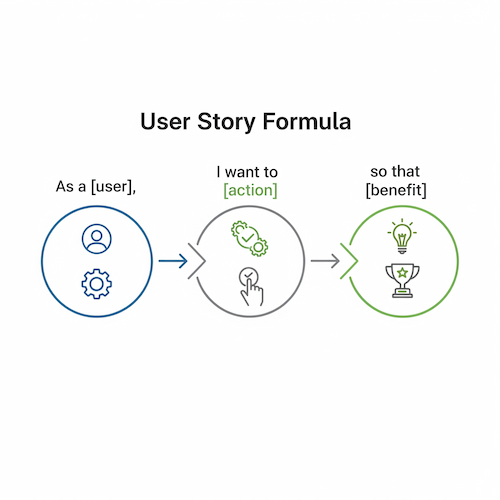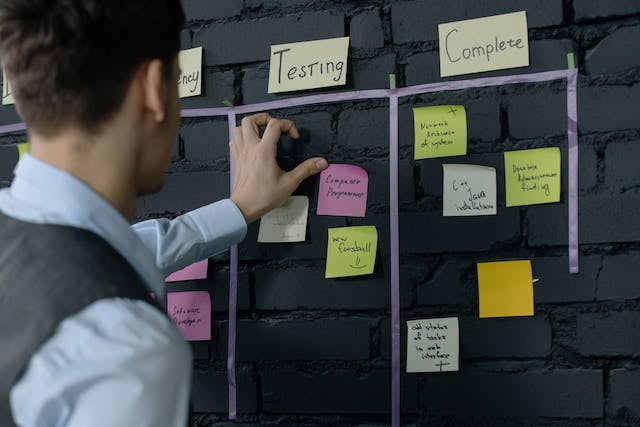Agile software development is a practice used by most technology companies because of the benefits it brings in terms of flexibility and efficiency. User stories play a key role in this approach, as they are important because they specify requirements, support teamwork, and keep product development in line with user needs. User stories act as a bridge between stakeholders and the development team, ensuring that both sides agree on the project's goals and requirements. In this article, you will learn what user stories are, what role they play in a project, and why it is worth paying more attention to them during the development.
Table of Contents:
1. User Stories: Definition and Key Features
2. How to prepare a good User Story?
3. User Stories as the foundation of Agile
4. CCC - Card, Conversation, Confirmation
6. User Stories in Discovery Phase
7. User Story Examples and Templates
Introduction to Agile Development
Modern software development has evolved beyond traditional waterfall methodologies, embracing agile frameworks that fundamentally transform how technology solutions are conceived, built, and delivered. This approach represents a strategic shift toward flexibility and stakeholder collaboration, ensuring that every development cycle generates measurable value. Instead of sticking to fixed, predefined processes, agile methodology breaks complex projects down into manageable iterations, enabling engineering team to respond dynamically to market changes and customer feedback. The framework operates through focused development cycles known as sprints, designed to deliver functional software components regularly and progressively.
The cornerstone of effective agile implementation lies in user stories - strategically crafted narratives that capture software requirements from the end user's business perspective. These stories function as essential communication bridges, connecting technical teams with business stakeholders and decision-makers. By concentrating on genuine user needs and underlying business drivers, Agile user stories ensure that every feature developed contributes directly to organizational objectives and market competitiveness. This methodology maintains sharp focus throughout the development lifecycle, guaranteeing that resources are invested in capabilities that deliver authentic value to both visitors and the broader business ecosystem.
If you’re looking for a partner who understands the unique challenges of SaaS application development - let’s talk. We’ve helped teams in fintech, foodtech, and beyond turn ideas into real, high-performing digital products.
User Stories: Definition and Key Features
A user story is a fundamental approach to defining software requirements from the customer's perspective. Following the format As a [user], I want to [action] so that [benefit], this method transforms abstract needs into concrete, actionable tasks that drive effective development. The power of user stories lies in their simplicity and clarity - they speak a language that resonates with everyone, from technical teams to executive leadership. This universality eliminates communication gaps, ensuring that every feature developed delivers measurable business value and aligns with organizational goals.

The power of US lies in their accessibility and clarity – they speak a language that resonates across all project stakeholders, from technical teams to executive leadership. This universal understanding eliminates the communication gaps that often derail software projects, ensuring that every feature developed delivers measurable value to your visitors and business. Whether your organization operates within Scrum, Kanban, or hybrid agile frameworks, user stories provide the foundation for user-centric development that consistently meets market expectations and drives sustainable business growth. The strategic implementation of well-crafted user stories often determines the difference between software that merely functions and solutions that truly transform how your business operates.

How to prepare a good User Story?
When preparing requirements for a project, it's essential to use a format that answers three key questions: who is the user, what do they need, and why is it important. Well-crafted stories enhance clarity, support effective communication, and play a vital role in the overall success of the project. Leveraging proven templates ensures consistency and helps teams capture needs in a structured way. By following best practices, it's easier to maintain high standards and clearly define expectations throughout the development.
- The first of these is the definition of the persona. It should indicate as much detail as possible relating to the end user, focusing on the goals and needs. The answer has to be concise in order to have as much detail as possible, and concise descriptions in user stories help simplify complex requirements and improve communication.
- The second is the question of purpose. Every project ought to have a defined vision. It outlines the purpose of the solution and helps meet the user’s needs.
- The last question relates to the reason. Before putting the software in the hands of the user, it is important to consider what the reason is for the software and what the solution being developed is supposed to be responsible for, always writing from the user’s point of view. For this purpose, all functionalities are considered to focus on working on those that are actually considered necessary. User stories should be specific and come with testable, clear acceptance criteria to measure success.

User Stories as the foundation of Agile
User Stories are the foundation of Agile, revolutionizing the approach to software development. Instead of focusing on rigid technical requirements, agile development is based on user needs, giving the team flexibility and adaptability. This makes the approach relatively flexible and responsive to change, which is crucial in the dynamic world of technology. User stories help teams prioritize work and deliver incremental value in each sprint.
For a user story to be effective, it should meet the INVEST criteria:
-
Independent: It can be implemented without depending on other stories.
-
Negotiable: It is open to discussion and can be changed.
-
Valuable: Provides real value to the user.
-
Estimable: The team is able to estimate the time needed for implementation.
-
Small: Can be implemented in a single sprint.
-
Testable: Can be verified to ensure it has been implemented correctly.
Applying these principles ensures that stories are well-defined, readable, and consistent with the project's goals.
From Backlog to Sprint
User stories are a key tool for managing the product backlog, planning sprints, and executing the entire development process. During the sprint planning phase, the product owner and the team decide which user stories will be tackled in a given iteration. These stories are often divided into smaller multiple stories, which facilitates management and delivers incremental value.
Throughout the development life cycle, user stories are subject to continuous refinement to keep them current and useful. This task falls mainly to the product owner, who works with the development and testing teams.
User stories are more than just documentation – they are a tool for building a common understanding within the team. Extreme programming and other agile practices emphasize that user stories are intended to encourage teams to adopt a customer-centric mindset. A proper understanding is critical to the success of a project in the Agile.
CCC - Card, Conversation, Confirmation
The user stories structure includes three elements that every project team should be aware of. It emphasises clear communication, collaboration and a shared understanding of what needs to be delivered, ensuring alignment with user needs and project objectives. Including input from even end users and gathering insights from focus groups helps capture the end user perspective, making the process more user-centric.
- The first component is the card, the space responsible for placing user stories. The charter does not necessarily have to contain the fully refined elements of the project. Its purpose is to get the team to discuss within the Agile.
- The second component included in the CCC charter is the conversation. Both the project owner and the development team should discuss each component of the implementation being done. The product manager is also involved in defining functional requirements and user-system interactions at this stage. Verbal communication with the support of technical documentation, testing and other data provides an adequate background for a substantive discussion, where technical requirements and technical details are discussed to ensure clarity. As a result, the conclusions drawn from it can completely revolutionise the perception of the project to date.
- The final factor is confirmation. These are the elaborated assumptions that must be met within a set period of time in order for the project to move forward in the coming future. These are set by the team in consultation with the stakeholders.

Benefits of User Stories
User stories deliver substantial value across development initiatives, establishing themselves as a fundamental pillar of successful agile methodologies. When organizations implement user stories effectively, development teams experience enhanced communication dynamics and stronger collaborative partnerships, ensuring every stakeholder gains clear visibility into objectives and requirements from the end user's business perspective. This unified understanding significantly reduces project risks and maintains strategic alignment throughout the entire development lifecycle.
The strategic advantage of user stories lies in their exceptional ability to illuminate genuine end user requirements with precision. By maintaining laser focus on what users actually need to accomplish their goals, user stories guide development teams toward building software capabilities that deliver measurable business impact. This user-centric methodology consistently produces superior products while driving higher customer satisfaction rates, as final deliverables align closely with real user expectations and often exceed initial requirements. Ultimately, user stories empower development teams to maintain unwavering focus on value delivery at every critical stage of the development journey.
Business Value
User stories serve as a strategic foundation for ensuring software development delivers measurable business impact. When development teams center their approach around genuine user needs and objectives, they create a clear pathway for prioritizing initiatives that drive real organizational value. This methodology enables teams to channel their technical expertise toward building solutions that truly matter, establishing a partnership between development efforts and business growth that maximizes investment returns.
The strategic advantage of user stories lies in their ability to guide development teams toward informed, value-driven decisions about feature prioritization. By maintaining continuous alignment between technical implementation and both user requirements and business goals, this approach ensures that software development becomes a trusted partner in organizational success rather than just a technical exercise. This focus on delivering authentic business value through user-centered development represents why user stories have become essential for companies seeking to transform their agile development processes into competitive advantages.
User Stories in Discovery Phase
Linking user stories together with the discovery phase has an impact on the product development process. By focusing on the user, developers can achieve a final result that is in line with the assumptions mentioned by the audience. However, before the discovery phase translates into the final product, the project team must responsibly approach the user’s role in the project. First and foremost, it is essential to listen to their needs and understand their pain points. User research - such as surveys, interviews, and analyzing feedback - plays a crucial role in gathering insights about users' behaviors, needs, and challenges, which directly inform the creation of effective user stories. When defining them, consider the actions and goals of a website visitor to ensure user needs are accurately captured. Knowing the realities of the potential audience of the software allows it to be better distributed and provide functionality.
The cooperation between the discovery phase and the user stories process helps to define the scope of the project. Defining its framework makes it possible to position the individual in the phase and prioritise tasks. Using user story mapping organizes and visualizes user stories, which clarifies the project scope and helps the team stay aligned. It is also important to remember that it is the user who leads the entire process, not the end product. The most common mistake is to design solutions that have no user demand. Therefore, both the business idea itself and the individual interfaces and experiences should be aligned with the expectations of the audience.
In considering user stories, the factor of risk mitigation is often underestimated. By dissecting every single element of the process, even the smallest, the occurrence of potential problems can be reduced. Refining user stories and focusing on requirements throughout the process leads to better user stories and more effective development tasks. Combined with the discovery phase, a solid bank of information is created that minimises the risks arising from ignorance.
check out our Discovery Phase process
User Story Examples and Templates
To create effective user stories, the Railwaymen development team uses well-thought-out, user-oriented templates that accurately reflect the real needs and business goals of customers. Below are examples of user stories for users such as mobile app users, online shoppers, and frequent travelers, which can be used in a variety of technology projects:
-
As a mobile app user, I want to intuitively search for and download new music so that I can enjoy my favorite songs no matter where I am.
-
As an online shopper, I want to complete my purchases efficiently and securely so that I can complete the transaction without unnecessary complications or technical barriers.
-
As a frequent traveler, I want to have constant access to my itinerary and booking information on my mobile device so that I can maintain full control over my schedule and stay organized.
How does Railwaymen approaches working on user stories?
At Railwaymen, the process of shaping user stories is not just a step - it's the foundation of every successful project. We treat the discovery phase as a critical stage where we meticulously translate your vision into a set of well-defined user stories. This process not only provides us with the necessary project knowledge but also helps us to precisely organize development tasks and priorities.
We don't just write user stories; we use them to build a shared understanding and ensure that every feature we develop delivers tangible value to your end users.
Ready to turn your ideas into a successful product? Contact us and let's discuss how our approach can accelerate the development of your next project.

%20(1)%20(2)%20(1).jpg)


